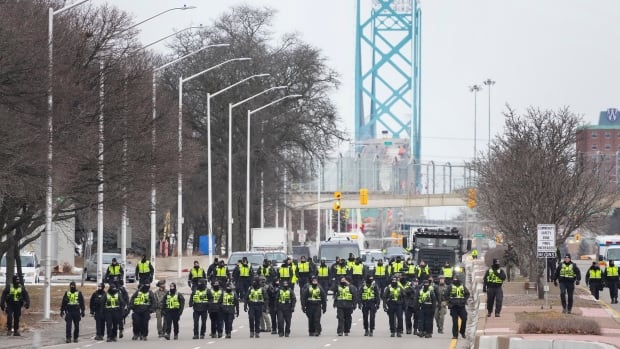
A senior Ontario bureaucrat says law enforcement in the province didn’t have the resources to address both convoy protests that were happening simultaneously in Ottawa and Windsor.
The comments were made in September during an exchange between Mario Di Tommaso, provincial deputy solicitor general, and lawyers for the Emergencies Act inquiry. A summary of that interview was entered into evidence before the Public Order Emergency Commission Wednesday.
Di Tommaso, whose portfolio includes oversight of the Ontario Provincial Police, said that around Feb. 10 the OPP shifted its focus from the protesters occupying Ottawa to the standoff at the Ambassador Bridge in Windsor – a decision he agreed with.
“Law enforcement had finite resources and could not effectively address situations in both Ottawa and Windsor at the same time,” according to his interview summary.
Di Tommaso said that while the Ottawa demonstration, which gridlocked parts of the city for nearly three weeks, posed a significant inconvenience, it wasn’t an overriding public safety risk.
Meanwhile, he told the commission, the blockade of the Ambassador Bridge was threatening the province’s economic security.
“It resulted in plants shutting down and lost jobs, and it raised concerns from American trade partners,” he said in the interview summary.
Premier Doug Ford agreed that Windsor should be the priority, according to a transcript of a call between Ford and Prime Minister Justin Trudeau made public Tuesday.
“The bigger one for us and the country is the Ambassador Bridge and the state [on the] ground there,” Ford told the prime minister.
The OPP took over as the lead agency responding to the Ambassador Bridge blockade on Feb. 9, after the Windsor Police Service (WPS) requested support from provincial, federal and nearby municipal police agencies.
Ontario, federal government argued over responsibility
The Emergencies Act was invoked after the Ambassador Bridge was cleared on Feb. 13 following a court injunction that led to the clearing of protesters in Windsor.
In his interview, Di Tommaso said there was a disagreement during a Feb. 6 call over which level of government was responsible for the Ottawa protest.
He recalled that federal national security adviser Jody Thomas suggested that Ontario should be dealing with the occupation in Ottawa instead of the federal government.
Di Tommaso told the commission he responded by pointing out that the demonstrators were protesting a federal vaccine mandate on Parliament’s doorstep.
“Moreover, it was open to the federal government to consider a number of possible policy or operational responses to the protests,” he said in his interview summary. “They could meet with protesters, modify federal vaccine mandates or provide necessary resources for a police response.”
The convoy movement began as a protest against the federal government’s vaccine policy for cross-border truckers. It morphed into a broader protest against COVID-19 mandates, including provincial restrictions.
Around Feb. 8, Di Tommaso said, OPP Commissioner Thomas Carrique told him that the RCMP was under enormous pressure.
“Mr. Di Tommaso confirmed that he understood the commissioner to be referring to pressure that was political in nature,” said Di Tommaso’s interview summary.
Di Tommaso to resume testimony Thursday
His witness statement echoed what the commission has heard already from the OPP – that the provincial police feared Ottawa Police Chief Peter Sloly hadn’t pulled together a plan to end the demonstrations.
“Di Tommaso explained that he understands that OPP resources could have been made available to [the Ottawa Police Service] much earlier if it had put a comprehensive plan into place. Such a plan would normally identify how many officers are required, how long they are required for, and their duties,” said the witness statement.
The deputy solicitor general told commission lawyers he felt the federal government’s use of the Emergencies Act was helpful but not necessary.
Di Tommaso began taking questions Wednesday but his testimony was cut off after Gabriel Poliquin, legal counsel representing the commission, collapsed to the floor.
First responders were called to the Library and Archives Canada building in downtown Ottawa, where the hearings are being held.
Poliquin’s condition remains unclear. A spokesperson for the commission said in an emailed statement that, out of respect for Poliquin and his family, it would share no further details about his health.
Di Tommaso, one of two Ontario officials on the witness list, is expected to return to the commission on Thursday to finish his testimony.
Ian Freeman, assistant deputy minister for Ontario’s Ministry of Transportation, stepped in to testify Wednesday afternoon instead.
He said the provincial government couldn’t suspend commercial vehicle operators’ registrations — despite requests to do so — without due process and proper evidence gathering.
A Federal Court judge ruled Monday that Ontario Premier Doug Ford and Sylvia Jones, the solicitor general at the time of the protests, will not have to testify before the Emergencies Act inquiry in Ottawa because of parliamentary privilege.